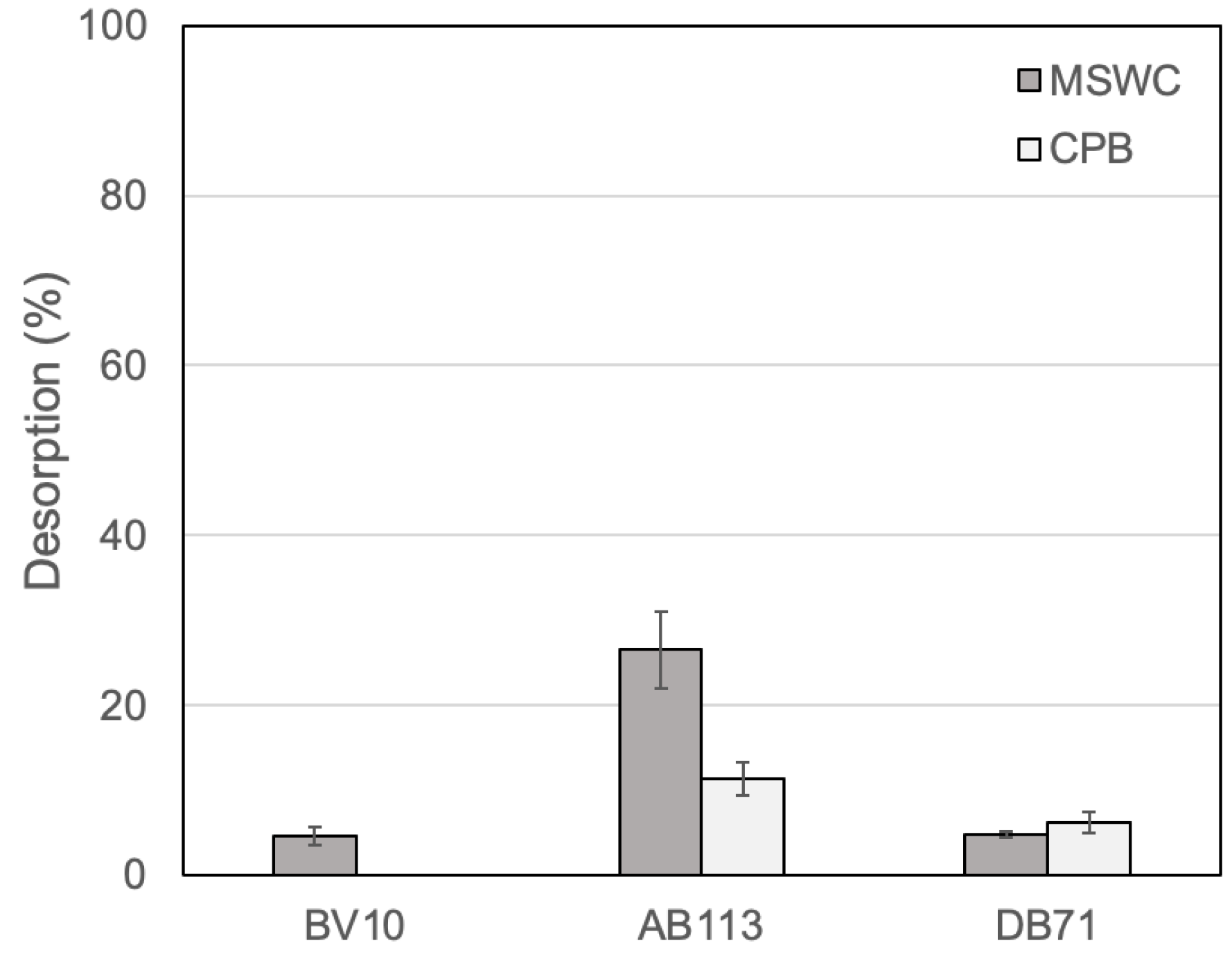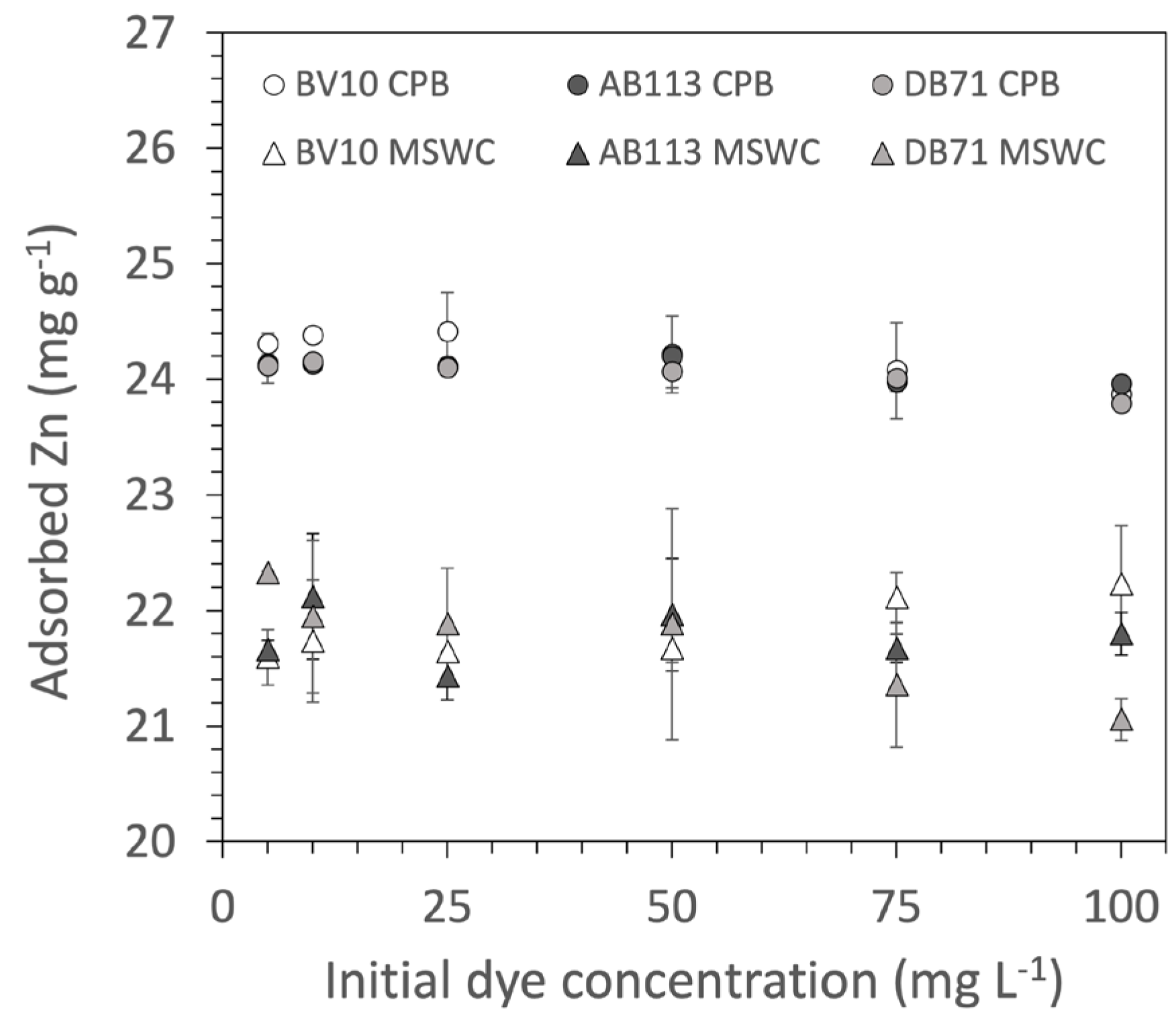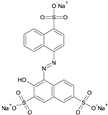Influence of Zinc and Humic Acids on Dye Adsorption from Water by Two Composts
Abstract
:1. Introduction
2. Materials and Methods
2.1. Adsorbates
2.2. Biosorbents
2.3. Adsorption Experiments
2.3.1. Single-Dye Solutions
2.3.2. Effect of Zn and Dissolved Organic Matter
2.4. Modeling of Adsorption Curves
3. Results and Discussion
4. Conclusions
Supplementary Materials
Author Contributions
Funding
Institutional Review Board Statement
Informed Consent Statement
Data Availability Statement
Conflicts of Interest
References
- O’Neill, C.; Hawkes, F.R.; Hawkes, D.L.; Lourenco, N.D.; Pinheiro, H.M.; Delée, W. Colour in textile effluents—Sources, measurement, discharge consents and simulation: A review. J. Chem. Technol. Biotechnol. 1999, 74, 1009–1018. [Google Scholar] [CrossRef]
- Slokar, Y.M.; Majcen Le Marechal, A. Methods of decoloration of textile wastewaters. Dye. Pigment. 1997, 37, 335–356. [Google Scholar] [CrossRef]
- Jain, A.K.; Gupta, V.K.; Bhatnagar, A.; Suhas. Utilization of industrial waste products as adsorbents for the removal of dyes. J. Hazard. Mater. 2003, 101, 31–42. [Google Scholar] [CrossRef] [PubMed]
- Crini, G. Non-conventional low-cost adsorbents for dye removal: A review. Bioresour. Technol. 2006, 97, 1061–1085. [Google Scholar] [CrossRef]
- Anastopoulos, I.; Kyzas, G.Z. Agricultural peels for dye adsorption: A review of recent literature. J. Mol. Liq. 2014, 200, 381–389. [Google Scholar] [CrossRef]
- Salleh, M.A.M.; Mahmoud, D.K.; Karim, W.A.W.A.; Idris, A. Cationic and anionic dye adsorption by agricultural solid wastes: A comprehensive review. Desalination 2019, 5, 91–108. [Google Scholar] [CrossRef]
- Zaidi, N.A.H.M.; Lim, L.B.L.; Usman, A.; Kooh, M.R.R. Efficient adsorption of malachite green dye using Artocarpus odoratissimus leaves with artificial neural network modelling. Desalination Water Treat. 2018, 101, 313–324. [Google Scholar] [CrossRef]
- McKay, G.; Hadi, M.; Samadi, M.T.; Rahmani, A.R.; Aminabad, M.S.; Nazemi, F. Adsorption of reactive dye from aqueous solutions by compost. Desalination Water Treat. 2011, 28, 164–173. [Google Scholar] [CrossRef]
- Anastopoulos, I.; Kyzas, G.Z. Composts as biosorbents for decontamination of various pollutants: A review. Water Air Soil Pollut. 2015, 226, 61–72. [Google Scholar] [CrossRef]
- Paradelo, R.; Moldes, A.B.; Barral, M.T. Treatment of red wine vinasses with non-conventional substrates for removing coloured compounds. Water Sci. Technol. 2009, 58, 1585–1592. [Google Scholar] [CrossRef] [Green Version]
- Paradelo, R.; Vecino, X.; Moldes, A.B.; Barral, M.T. Potential use of composts and vermicomposts as low-cost adsorbents for dye removal: An overlooked application. Environ. Sci. Pollut. Res. 2019, 26, 21085–21097. [Google Scholar] [CrossRef]
- Pushpa, T.; Vijayaraghavan, J.; Jegan, J. Utilization of Effective Microorganisms based water hyacinth compost as biosorbent for the removal of basic dyes. Desalination Water Treat. 2016, 57, 24368–24377. [Google Scholar] [CrossRef]
- Dey, M.D.; Das, S.; Kumar, R.; Doley, R.; Bhattacharya, S.S.; Mukhopadhyay, R. Vermiremoval of methylene blue using Eisenia fetida: A potential strategy for bioremediation of synthetic dye-containing effluents. Ecol. Eng. 2017, 106, 200–208. [Google Scholar] [CrossRef]
- Paradelo, R.; Al-Zawahreh, K.; Barral, M.T. Utilization of composts for adsorption of methylene blue from aqueous solutions: Kinetics and equilibrium studies. Materials 2020, 13, 2179. [Google Scholar] [CrossRef]
- Al-Zawahreh, K.; Barral, M.T.; Al-Degs, Y.; Paradelo, R. Comparison of the sorption capacity of basic, acid, direct and reactive dyes by compost in batch conditions. J. Environ. Manag. 2021, 294, 113005. [Google Scholar] [CrossRef]
- Al-Zawahreh, K.; Al-Degs, Y.; Barral, M.T.; Paradelo, R. Optimization of Direct Blue 71 sorption by organic rich-compost following multilevel multifactor experimental design. Arab. J. Chem. 2022, 15, 103468. [Google Scholar] [CrossRef]
- Al-Zawahreh, K.; Barral, M.T.; Al-Degs, Y.; Paradelo, R. Competitive removal of textile dyes from solution by pine bark-compost in batch and fixed bed column experiments. Environ. Technol. Innov. 2022, 27, 102421. [Google Scholar] [CrossRef]
- Bisschops, I.; Spanjers, H. Literature review on textile wastewater characterization. Environ. Technol. 2003, 24, 1399–1411. [Google Scholar] [CrossRef]
- R Core Team. R: A Language and Environment for Statistical Computing; R Foundation for Statistical Computing: Vienna, Austria, 2018. [Google Scholar]
- Fox, J.; Bouchet-Valat, M. Rcmdr: R Commander, R package version 2.8-0; R Foundation for Statistical Computing: Vienna, Austria, 2022. [Google Scholar]
- Baty, F.; Ritz, C.; Charles, S.; Brutsche, M.; Flandrois, J.-P.; Delignette-Muller, M.-L. A toolbox for nonlinear regression in R: The package nlstools. J. Stat. Softw. 2015, 66, 1–21. [Google Scholar] [CrossRef] [Green Version]
- Yu, Y.; Murthy, B.; Shapter, J.; Constantopoulos, K.; Voelcker, N.; Ellis, A. Benzene carboxylic acid derivatized graphene oxide nanosheets on natural zeolites as effective adsorbents for cationic dye removal. J. Hazard. Mater. 2013, 260, 330–338. [Google Scholar] [CrossRef]
- Filipkowska, U.; Jóźwiak, T.; Szymczyk, P.; Kuczajowska-Zadrożna, M. The use of active carbon immobilised on chitosan beads for RB5 and BV10 dye removal from aqueous solutions. Prog. Chem. Appl. Chitin Its Deriv. 2017, 22, 14–26. [Google Scholar] [CrossRef] [Green Version]
- Jóźwiak, T.; Filipkowska, U.; Zajko, P. Use of citrus fruit peels (grapefruit, mandarin, orange, and lemon) as sorbents for the removal of Basic Violet 10 and Basic Red 46 from aqueous solutions. Desalination Water Treat. 2019, 163, 385–397. [Google Scholar] [CrossRef]
- Jóźwiak, T.; Filipkowska, U.; Rodziewicz, J.; Mielcarek, A.; Owczarkowska, D. Application of compost as a cheap sorbent for dyes removal from aqueous solutions. Rocz. Ochr. Srodowiska 2013, 15, 2398–2411. [Google Scholar]
- Lee, L.Y.; Gan, S.; Tan, M.S.Y.; Lim, S.S.; Lee, X.J.; Lam, Y.F. Effective removal of Acid Blue 113 dye using overripe Cucumis sativus peel as an eco-friendly biosorbent from agricultural residue. J. Clean. Prod. 2016, 113, 194–203. [Google Scholar] [CrossRef]
- Hoseinzadeh, E.; Samarghandi, M.R.; McKay, G.; Rahimi, N.; Jafari, J. Removal of acid dyes from aqueous solution using potato peel waste biomass: A kinetic and equilibrium study. Desalination Water Treat. 2014, 52, 4999–5006. [Google Scholar] [CrossRef]
- Wawrzkiewicz, M.; Nowacka, M.; Klapiszewski, L.; Hubicki, Z. Treatment of wastewaters containing acid, reactive and direct dyes using aminosilane functionalized silica. Open Chem. 2015, 13, 82–95. [Google Scholar] [CrossRef]
- Wawrzkiewicz, M.; Wiśniewska, M.; Gun’koc, V.M.; Zarkoc, V.I. Adsorptive removal of acid, reactive and direct dyes from aqueous solutions and wastewater using mixed silica–alumina oxide. Powder Technol. 2015, 278, 306–315. [Google Scholar] [CrossRef]
- Buliut, Y.; Gözübenli, N.; Aydin, H. Equilibrium and kinetics studies for adsorption of direct blue 71 from aqueous solution by wheat shells. J. Hazard. Mater. 2007, 144, 300–306. [Google Scholar] [CrossRef]
- Abasi, M. Synthesis and characterization of magnetic nanocomposite of chitosan/SiO2/carbon nanotubes and its application for dyes removal. J. Clean. Prod. 2017, 145, 105–113. [Google Scholar] [CrossRef]
- Moradi, R. Adsorption of Azo Dye Direct Blue 71 from Aqueous Solution Using NiFe2O4/CP Nanoparticles: Kinetic and Isotherm Model. Russ. J. Phys. Chem. A 2018, 92, 2781–2789. [Google Scholar] [CrossRef]
- Baseri, J.R.; Palanisamy, P.N.; Sivakumar, P. Comparative studies of the adsorption of direct dye on activated carbon and conducting polymer composite. J. Chem. 2012, 9, 1122–1134. [Google Scholar] [CrossRef] [Green Version]
- Visa, M.; Bogatu, C.; Duta, A. Simultaneous adsorption of dyes and heavy metals from multicomponent solutions using fly ash. Appl. Surf. Sci. 2010, 256, 5486–5491. [Google Scholar] [CrossRef]
- Hernández-Montoya, V.; Pérez-Cruz, M.A.; Mendoza-Castillo, D.I.; Moreno-Virgen, M.R.; Bonilla-Petriciolet, A. Competitive adsorption of dyes and heavy metals on zeolitic structures. J. Environ. Manag. 2013, 116, 213–221. [Google Scholar] [CrossRef]
- Paradelo, R.; Barral, M.T. Evaluation of the potential capacity as metal biosorbents of two MSW composts with different Cu, Pb and Zn content. Bioresour. Technol. 2012, 104, 810–813. [Google Scholar] [CrossRef]
- Zermane, F.; Cheknane, B.; Basly, J.P.; Bouras, O.; Baudu, M. Influence of humic acids on the adsorption of Basic Yellow 28 dye onto an iron organo–inorgano pillared clay and two Hydrous Ferric Oxides. J. Colloid Interface Sci. 2013, 395, 212–216. [Google Scholar] [CrossRef]




| Dye | Molecular Formula | Structure | Molecular Weight (g mol−1) | Water Solubility (g L−1) |
|---|---|---|---|---|
| Basic Violet 10 | C28H31ClN2O3 |  | 478.5 | 8–15 |
| Acid Blue 113 | C32H21N5Na2O6S2 |  | 681.7 | 40 |
| Direct Blue 71 | C40H23N7Na4O13S4 |  | 1029.9 | 10 |
| CPB | MSWC | |
|---|---|---|
| pHW | 5.3 | 8.5 |
| pHPZC | 4.4 | 8.1 |
| EC, dS m−1 | 0.4 | 7.0 |
| OM, % | 91.4 | 41.8 |
| C, % | 53.1 | 24.3 |
| N, % | 0.28 | 1.6 |
| C/N ratio | 194 | 16 |
| CEC, cmol(+) kg−1 | 25.4 | 18.8 |
| AEC, cmol(−) kg−1 | 4.6 | 3.6 |
| SSA, m2 g−1 | 22.4 | 5.8 |
| Dye | Compost | Factor | Langmuir | Freundlich | ||||||||
|---|---|---|---|---|---|---|---|---|---|---|---|---|
| KL | p | qm | p | R2 | KF | p | 1/n | p | R2 | |||
| BV10 | CPB | - | 0.11 ± 0.05 | 0.08 | 41.7 ± 10.2 * | 0.01 | 0.985 | 5.2 ± 0.9 ** | 0.004 | 0.63 ± 0.08 ** | 0.002 | 0.979 |
| Zn | 0.16 ± 0.09 | 0.14 | 39.3 ± 12.1 * | 0.03 | 0.981 | 6.2 ± 1.1 ** | 0.005 | 0.62 ± 0.11 ** | 0.004 | 0.980 | ||
| DOM | - | - | - | - | - | 1.3 ± 0.2 * | 0.01 | 1.20 ± 0.08 *** | 0.0006 | 0.935 | ||
| MSWC | - | 0.04 ± 0.03 | 0.25 | 6.8 ± 3.9 | 0.16 | 0.992 | 0.31 ± 0.04 ** | 0.001 | 0.78 ± 0.06 *** | 0.0002 | 0.993 | |
| Zn | 0.10 ± 0.04 | 0.06 | 3.4 ± 0.8 * | 0.01 | 0.985 | 0.33 ± 0.04 ** | 0.001 | 0.72 ± 0.06 *** | 0.0003 | 0.988 | ||
| DOM | 0.03 ± 0.03 | 0.46 | 10.4 ± 10.9 | 0.39 | 0.991 | 0.30 ± 0.06 ** | 0.006 | 0.83 ± 0.10 ** | 0.001 | 0.990 | ||
| AB113 | CPB | - | 0.16 ± 0.03 ** | 0.007 | 3.0 ± 0.3 *** | 0.0004 | 0.993 | 0.45 ± 0.06 ** | 0.002 | 0.61 ± 0.06 *** | 0.0007 | 0.981 |
| Zn | 0.38 ± 0.15 | 0.07 | 2.2 ± 0.3 ** | 0.001 | 0.990 | 0.70 ± 0.10 ** | 0.002 | 0.39 ± 0.07 ** | 0.004 | 0.988 | ||
| DOM | - | - | - | - | - | 0.11 ± 0.02 ** | 0.002 | 1.01 ± 0.05 *** | 0.00005 | 0.997 | ||
| MSWC | - | 0.51 ± 0.20 | 0.07 | 2.4 ± 0.4 ** | 0.003 | 0.977 | 0.8 ± 0.1 ** | 0.002 | 0.47 ± 0.09 ** | 0.007 | 0.972 | |
| Zn | 4.6 ± 8.5 | 0.62 | 2.3 ± 0.9 | 0.06 | 0.859 | 1.8 ± 0.4 * | 0.01 | 0.18 ± 0.27 | 0.54 | 0.859 | ||
| DOM | 11.0 ± 10.3 | 0.62 | 1.8 ± 0.3 ** | 0.004 | 0.910 | 1.5 ± 0.2 ** | 0.002 | 0.21 ± 0.12 | 0.14 | 0.937 | ||
| DB71 | CPB | - | 0.02 ± 0.03 | 0.43 | 0.5 ± 0.2 | 0.12 | 0.765 | 0.04 ± 0.03 | 0.26 | 0.49 ± 0.19 | 0.06 | 0.772 |
| Zn | 0.007 ± 0.006 | 0.29 | 1.3 ± 0.7 | 0.16 | 0.964 | 0.02 ± 0.01 | 0.12 | 0.78 ± 0.13 ** | 0.004 | 0.962 | ||
| DOM | 0.034 ± 0.008 * | 0.01 | 0.32 ± 0.03 *** | 0.0004 | 0.988 | 0.02 ± 0.01 | 0.07 | 0.53 ± 0.10 ** | 0.007 | 0.945 | ||
| MSWC | - | 0.05 ± 0.02 | 0.09 | 1.3 ± 0.2 ** | 0.005 | 0.964 | 0.14 ± 0.04 * | 0.02 | 0.50 ± 0.07 ** | 0.003 | 0.965 | |
| Zn | 0.09 ± 0.02 * | 0.02 | 1.4 ± 0.1 *** | 0.0005 | 0.993 | 0.21 ± 0.03 ** | 0.001 | 0.46 ± 0.04 *** | 0.0002 | 0.994 | ||
| DOM | 0.06 ± 0.02 * | 0.04 | 1.5 ± 0.2 ** | 0.002 | 0.991 | 0.17 ± 0.03 ** | 0.003 | 0.50 ± 0.05 *** | 0.0004 | 0.993 |
Disclaimer/Publisher’s Note: The statements, opinions and data contained in all publications are solely those of the individual author(s) and contributor(s) and not of MDPI and/or the editor(s). MDPI and/or the editor(s) disclaim responsibility for any injury to people or property resulting from any ideas, methods, instructions or products referred to in the content. |
© 2023 by the authors. Licensee MDPI, Basel, Switzerland. This article is an open access article distributed under the terms and conditions of the Creative Commons Attribution (CC BY) license (https://creativecommons.org/licenses/by/4.0/).
Share and Cite
Paradelo, R.; García, P.; González, A.; Al-Zawahreh, K.; Barral, M.T. Influence of Zinc and Humic Acids on Dye Adsorption from Water by Two Composts. Int. J. Environ. Res. Public Health 2023, 20, 5353. https://doi.org/10.3390/ijerph20075353
Paradelo R, García P, González A, Al-Zawahreh K, Barral MT. Influence of Zinc and Humic Acids on Dye Adsorption from Water by Two Composts. International Journal of Environmental Research and Public Health. 2023; 20(7):5353. https://doi.org/10.3390/ijerph20075353
Chicago/Turabian StyleParadelo, Remigio, Paula García, Alba González, Khaled Al-Zawahreh, and Maria Teresa Barral. 2023. "Influence of Zinc and Humic Acids on Dye Adsorption from Water by Two Composts" International Journal of Environmental Research and Public Health 20, no. 7: 5353. https://doi.org/10.3390/ijerph20075353







